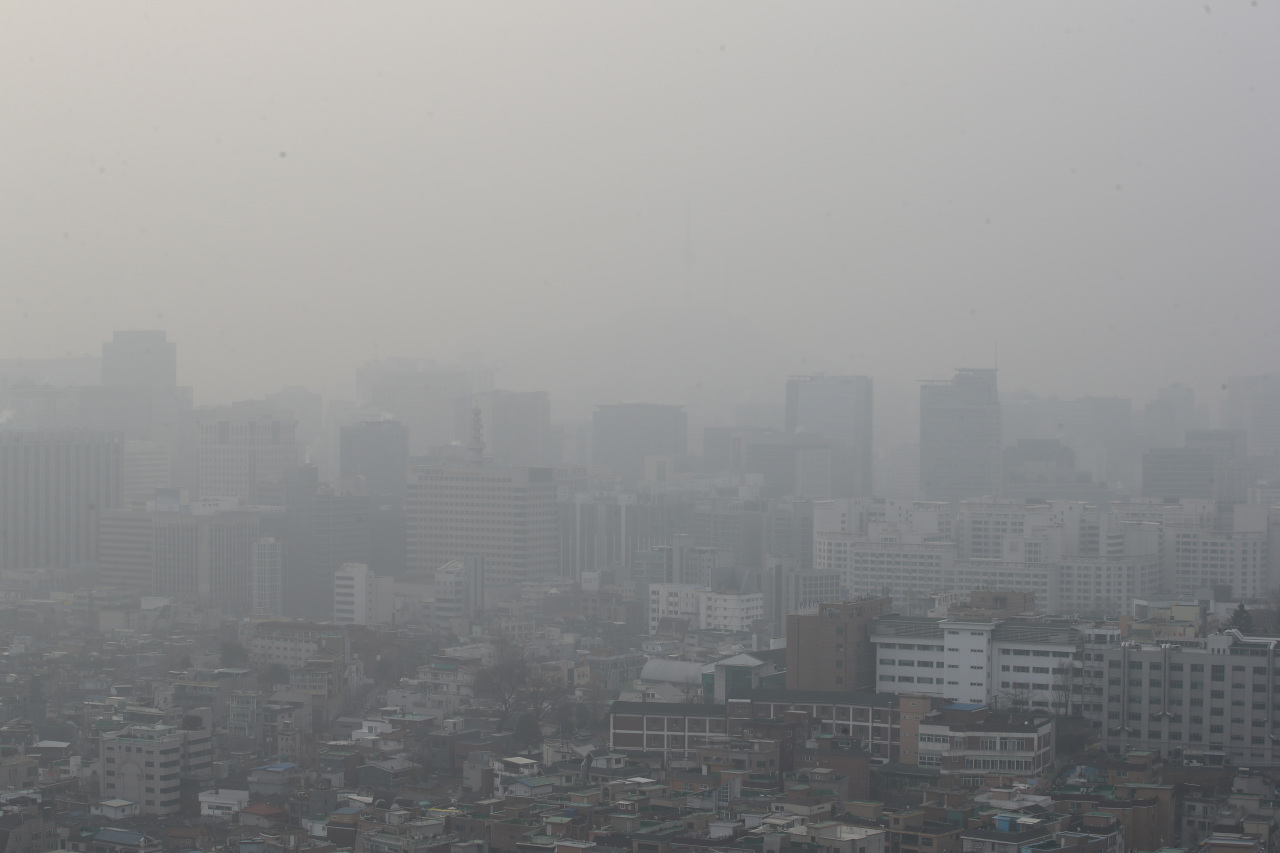Ultrafine dust pollution continues, with yellow dust expected Tuesday
By Ko Jun-taePublished : March 15, 2021 - 14:48

Authorities are under pressure as fine dust levels remain threateningly high in South Korea despite emergency measures to reduce air pollution.
An ultrafine dust alert was issued in Seoul on Monday at 11 a.m., as the concentration level reached 76 micrograms per cubic meter, according to the Korea Environment Corporation. Similar alerts were issued for 13 cities and counties in Gyeonggi Province, where ultrafine dust levels were as high as 81 micrograms per cubic meter.
Alerts are issued when ultrafine dust, also known as PM 2.5, reaches concentrations of 75 micrograms per cubic meter, which is categorized as “very bad.” Ultrafine dust poses health risks when inhaled, as it is retained in the lungs longer than fine dust and can cause lung inflammation.
It was predicted that the ultrafine dust would remain thick across Korea until Tuesday afternoon.
The air pollution crisis in Korea has persisted for years, and becomes especially serious during spring. But with the continued influx of fine dust and ultrafine dust particles from China and the lack of atmospheric movement across Korea, it is even more critical this year.
The situation has prompted authorities to enforce emergency ultrafine dust response measures across the Greater Seoul region, which includes Incheon and Gyeonggi Province, as well as in North Chungcheong and South Chungcheong provinces.
Under the Ministry of Environment’s emergency measures, in effect Monday from 6 a.m. to 9 p.m., 11 coal plants in those regions were shut down and a production limit of 80 percent was imposed for 23 other coal plants.
Vehicles with the lowest score under the nation’s five-tier emission standards system were barred from the roads. Industrial and construction sites responsible for high fine dust emissions were required to limit their operations, and roads were to be sprayed with water.
Although the ultrafine dust is expected to clear up Tuesday, air pollution risks still remain high for Korea as yellow dust -- prevalent in Beijing at the moment -- is forecast to fly into Korea on Tuesday.
China is reportedly experiencing its worst yellow dust levels in the past 10 years, part of which will reach Korea early Tuesday morning backed by strong winds from the northwest, according to the Korea Meteorological Administration.
The weather agency added that the yellow dust is forecast to stay in the country until Wednesday, but could remain in force in later hours.
By Ko Jun-tae (ko.juntae@heraldcorp.com)
An ultrafine dust alert was issued in Seoul on Monday at 11 a.m., as the concentration level reached 76 micrograms per cubic meter, according to the Korea Environment Corporation. Similar alerts were issued for 13 cities and counties in Gyeonggi Province, where ultrafine dust levels were as high as 81 micrograms per cubic meter.
Alerts are issued when ultrafine dust, also known as PM 2.5, reaches concentrations of 75 micrograms per cubic meter, which is categorized as “very bad.” Ultrafine dust poses health risks when inhaled, as it is retained in the lungs longer than fine dust and can cause lung inflammation.
It was predicted that the ultrafine dust would remain thick across Korea until Tuesday afternoon.
The air pollution crisis in Korea has persisted for years, and becomes especially serious during spring. But with the continued influx of fine dust and ultrafine dust particles from China and the lack of atmospheric movement across Korea, it is even more critical this year.
The situation has prompted authorities to enforce emergency ultrafine dust response measures across the Greater Seoul region, which includes Incheon and Gyeonggi Province, as well as in North Chungcheong and South Chungcheong provinces.
Under the Ministry of Environment’s emergency measures, in effect Monday from 6 a.m. to 9 p.m., 11 coal plants in those regions were shut down and a production limit of 80 percent was imposed for 23 other coal plants.
Vehicles with the lowest score under the nation’s five-tier emission standards system were barred from the roads. Industrial and construction sites responsible for high fine dust emissions were required to limit their operations, and roads were to be sprayed with water.
Although the ultrafine dust is expected to clear up Tuesday, air pollution risks still remain high for Korea as yellow dust -- prevalent in Beijing at the moment -- is forecast to fly into Korea on Tuesday.
China is reportedly experiencing its worst yellow dust levels in the past 10 years, part of which will reach Korea early Tuesday morning backed by strong winds from the northwest, according to the Korea Meteorological Administration.
The weather agency added that the yellow dust is forecast to stay in the country until Wednesday, but could remain in force in later hours.
By Ko Jun-tae (ko.juntae@heraldcorp.com)


![[Exclusive] Korean military set to ban iPhones over 'security' concerns](http://res.heraldm.com/phpwas/restmb_idxmake.php?idx=644&simg=/content/image/2024/04/23/20240423050599_0.jpg&u=20240423183955)

![[Graphic News] 77% of young Koreans still financially dependent](http://res.heraldm.com/phpwas/restmb_idxmake.php?idx=644&simg=/content/image/2024/04/22/20240422050762_0.gif&u=)



![[Pressure points] Leggings in public: Fashion statement or social faux pas?](http://res.heraldm.com/phpwas/restmb_idxmake.php?idx=644&simg=/content/image/2024/04/23/20240423050669_0.jpg&u=)









